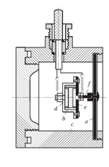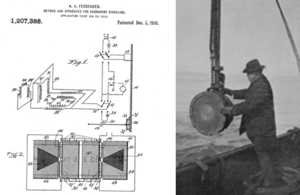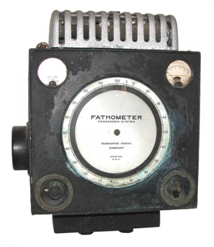Sonar
The disappearance of Malaysian Airlines Flight 370 and the massive search that has followed left many in the media and the general public puzzled. In an age where everything we would ever want seems but a “click” away, why was it so difficult to find the plane and its black box? As each news outlet paraded their experts to explain the difficulties, it became clear that most people had little appreciation of the vastness and impenetrability of the world’s oceans. “We know more about the Moon’s surface than we do about the bottom of the oceans,” became a common refrain as experts tried to explain the almost unsurmountable challenges of finding the wreckage of Flight 370, let alone its “black box,” at depths of three miles. Our limited ability to probe the oceans’ depths also came as a surprise to many. The electromagnetic spectrum is not effective deep under the water. The same cannot be said, however, for acoustical waves. As terms like “towed pinger” and “side-scanning sonar” were bandied about in the news, the public started to discover the unique role of sound in understanding and exploring the underwater world. The history of sonar technology is often associated with the story of anti-submarine warfare. But few are aware that the earliest technological developments in underwater acoustics emerged at the close of 19th century in efforts to overcome the dangers of fog to maritime commerce.
The single biggest challenge to the safety of maritime commerce in the 19th century lay close to shore and not off on the high seas. Captains had to be ever vigilant of reefs, shoals, and rocks as they brought their ships close to shore. During the day, armed with good charts, the visual sightings of landmarks helped the captain situate himself relative to known hazards. As ships coming off the high seas converged on ports, the opportunities for collisions increased. But on a clear day, where one could see for miles, there was little chance of two ships colliding, especially if the captains were attentive. The night, however, was a different matter. Throughout history, maneuvering a ship in the dark close to shore had always been a very dangerous undertaking to be avoided if at all possible. The night could easily conceal the whereabouts of hazards and ships. The growing use of lighthouses and lightships during the 19th century, particularly with the advent of arc lighting, mitigated some of the dangers to ships traveling at night. During the second half of the 19th century, international maritime conventions codified the use of navigation lights by ships in order to minimize collisions at night. Despite these advances to the safety of navigation, there still lay another source of great danger for ships close to shore.
Fog can cloak all manner of hazards, whether they be in the daytime or at night. Imagine coming close to shore on the way to a port when a thick fog sets in. All the visual clues from any landmarks, lighthouses, lightships, or shipboard lights are shrouded in the thick fog. Reefs, shoals, rocks, or other ships are around you but you can’t be sure where. The only signaling system left was sound. To communicate their presence, lighthouses and lightships in 19th century were equipped with bells or horns, as were ships. In so doing they alerted mariners to nearby hazards. Despite the use of sound signals, losses to shoals, rocks, reefs, and inter-ship collisions were considerable. With ships getting bigger and faster because of steam power, and the volume cargo and passenger traffic ever increasing, these losses were bound to increase.
The Lighthouse Board and Trinity House were responsible for the safety of maritime commerce off their respective coastlines: the Lighthouse Board for the United States and Trinity House for the U.K. Both these organizations were deeply concerned about the difficulties associated with sound signals. In the mid-1870s, they engaged prominent scientists to look into the matter. John Tyndall, in Great Britain, and Joseph Henry, in the United States, reaffirmed the experiences of mariners who had been bedeviled by the fog: sound traveling through air was completely untrustworthy as a method for safe navigation in fog. Gradients in wind speed and in temperature created considerable uncertainty as to the distance and direction to the source of the sound. More powerful sirens were their only recommendations offered. But a handful of inventive spirits took a fresh look at the problem of signaling by sound. If, for the purposes of safe navigation, air was an unsuitable medium for propagating warning sounds, perhaps water offered a better option. In 1826, while floating on Lake Geneva on two boats, the Swiss physicist J. D. Colladon (1802-1893) and the French mathematician J. K. F. Sturm (1802-1855) were the first to measure the speed of sound in water. Their experiment revealed one of sound’s interesting propagation properties; it travels four times faster in water than in air. The invention of the telephone in 1876, presented a new paradigm for detecting acoustic signals in water. Rather than the crude ear trumpet submerged in water, as had been used by Colladon and Sturm, the transmitter on the telephone offered a more sensitive electromechanical model that converted acoustic waves to electrical signals. A small number of “submarine” (underwater) signaling systems were proposed in the late 1870s as ways to improve navigation in a fog. But nothing ever came of them and they were soon forgotten.
The Submarine Signal Co. is born
In the closing years of the 19th century, A. J. Mundy became convinced that he could devise a practical submarine signaling system to improve the safety of navigation. Little is known about Mundy. But J. B. Millet, a contemporary who worked with him, recalls Mundy telling people his vivid childhood recollections of bathing in a lake, with his head in the water, and being able to hear stones being cracked together a considerable distance away. His early experiments proved promising. He then joined forces with the electrical engineer Elisha Gray, a co-founder of Western Electric and a pioneer in telephony. After some experimentation, Gray adapted a waterproofed version of Edison’s carbon-button microphone for use underwater electro-acoustics. Working together, Mundy and Gray then tackled the design of a mechanism to produce powerful underwater sounds. In 1899, they patented a way to transmit sounds efficiently over considerable distances underwater. This U.S. patent, 636,5l9, clearly reveals their broader vision for underwater communications: “Our invention,” explained Mundy and Gray, “relates to a method of ringing or sounding a bell and also to a system and apparatus for transmitting intelligence [emphasis added] between ships at sea and between the shore and any ship by means of sound-signals made in the water.” Through underwater communications, they argued, ships could navigate safely in the fog. According to the patent claims, pairs of electromagnets rang the bell at its resonant frequency and eliminated all overtones, thus improving sound propagation. The method also allowed one to generate a sound of constant intensity that could be easily switched on and off.
Mundy and Gray made plans to form a company to commercialize their patent. Though Gray lived to see the system tested, he died just before Mundy and Josiah Millet launched the Submarine Signal Co., of Boston, in 1901. In the same year, the Submarine Signal Co. obtained the rights to install its underwater signaling system in Boston Harbor. According to the 23 August 1901¬¬ issue of the Electrical Engineer, inbound ships to Boston Harbor could “determine their position 10 – 12 miles from the shore, thus escaping the danger of approaching too near dangerous shoals in the vicinity of the entrance to the harbor.“ In time the company learned how to isolate the ship’s microphones from the sounds produced by the ships engines. With two microphones on either side of the ship, the Submarine Signal Co. system allowed for binaural detection; direction to the source was very accurate. A 1907 Admiralty report praised the efficacy of underwater signaling. “The Submarine Bell increases the range at which the fog signal can be heard by a vessel until it approximates to the range of a light-vessel's light in clear weather … safe navigation in fog in distance far beyond the range of aerial fog signals if the vessel is equipped with receivers. To double or treble the distance at which the fog signals can be heard is a great advantage to shipping and the facility of determining the direction of a sound signal is in itself a very valuable discovery.” By the end of 1910, the company had installed its underwater bell in three key lightships along the northeast coast. Hundreds of ships, including some of the great ocean liners of the day, were equipped with Submarine Signal acoustic detection devices. It was now possible, merely by the sound of the bells coming through the water, for an ocean liner to navigate its way safely past Nantucket Shoals and on to New York harbor, all without ever seeing a lightship or hearing a fog horn.
Fessenden Oscillator
Underwater communication through acoustics, in its broadest sense, had been on Gray’s and Mundy’s minds when they filed their 1899 patent. Land-based telegraphy was not appropriate for ship-to-shore and ship-to-ship communications. Semaphore and signal flags were possibilities on a clear day or night, but not when there was fog. With radio telegraphy still in its embryonic stages, there was still room for another “wireless” paradigm. Although an ingenious device, the Submarine Signal Co. realized that its underwater bell had limited utility for more generalized communications. In 1912, the company hired Reginald Aubrey Fessenden to design a better underwater device for producing acoustical waves. A prolific inventor, Fessenden had been a pioneer in the development of radio technology. Years later in 1921, Fessenden was awarded IRE’s Medal of Honor for his work in radio. Hoping to commercialize Fessenden’s radio inventions, in 1902, two Pittsburgh investors created “The National Electric Signaling Co.” (NESCO) In 1911, after being kicked out of NESCO, Fessenden walked away from radio technology and never returned. Fessenden was now open to new “wireless” challenges.
Fessenden created the first electro-acoustic oscillator. The acoustic power transmitted into the water was about 2 kW at a resonant frequency of 540 Hz, and the electroacoustic efficiency was 40–50%. Just 100 years ago, in June 1914, Fessenden demonstrated underwater telegraphy in a dramatic fashion. Spectators watched in amazement as he communicated with an unseen ship just beyond the horizon. Just two weeks earlier, a Norwegian collier collided in the fog with the ocean liner Empress of Ireland; a thousand people died. As one writer of the day reminded his audience, the tragedy could have been averted if both ships had been able to use Fessenden’s system. Having barely started with telegraphy, Submarine Signal Co. started to experiment with underwater telephony. In the end, underwater telegraphy was too expensive to be commercially viable. As marine radio telegraphy started to spread, the writing on the wall was clear; there would not be any commercial future for underwater communications using acoustical waves.
In search of a new business model, the Submarine Signal Co. astutely pivoted around Fessenden’s oscillator and turned its R&D focus to underwater sensing. On 14 April 1912, the Titanic sank, killing more than 1,500 people, because an iceberg could not be detected in time. In 1913, Submarine Signal Co. was able to demonstrate the detection of an iceberg using Fessenden’s Oscillator. The more profitable application of the Fessenden oscillator, however, was for the measurement of water depth. Any device that could measure a ship’s depth in real-time would be a great benefit to the safety of maritime commerce. The Submarine Signal Co. developed the “Fathometer,” a name that it also trademarked.
This device held out the promise of more efficient ways to carry out bathymetric studies. Up to 1914, the usual way for doing depth soundings involved throwing a heavy lead weight, tied to a long line, over the side. On the line were markings indicating length from the lead weight. As the weight touched the sea bottom and the line went taut, one could read the depth off the line. It was a cumbersome and time consuming process. Bouncing acoustical waves off the bottom offered a new, more accurate, far more efficient way to chart the depth of large areas. Armed with more accurate charts, any ship equipped with a “Fathometer” could immediately know if the sea bottom held out any dangers. In presenting Fessenden with its 1929 Gold Medal, Scientific American recognized that the “Fathometer” had ushered in a new era of underwater research.
Conclusion
With the onset of WWI and the emergence of the submarine as a new force in naval warfare, the focus of underwater acoustics research turned almost entirely to antisubmarine warfare. At first the emphasis was on passive detection. The U.K. and the United States developed sophisticated towed “hydrophones,” whose purpose was to detect the acoustical signatures given off by German submarine engines. They were towed to minimize the impact of the noise produced by the vessel that was hunting the submarine. Not only did these devices represent innovations in electro-acoustics, they also represented achievements in marine engineering. Mundy had first proposed the notion of towing a hydrophone in his 1903 U.S. patent application. Of course, his purpose was to improve the reception of underwater signaling. In fact, it was in this patent where Mundy coined the term “hydrophone.” Echolocation was the other approach to antisubmarine detection. A ship on the surface would send acoustical pulses down into the water. If there was a submarine below, it would show up as a reflected signal. Despite its role in the Fathometer, Fessenden’s oscillator was inadequate for the needs of detecting submarines. It could not generate the sharp pulses or frequency ranges needed. A new kind of transducer was needed to produce the acoustic pulses required for the active detection of submarines. The breakthrough came during the closing years of World War I and the pioneering work of the French physicist Paul Langevin. His work on the exploitation of the piezoelectric properties of quartz opened the door to dramatic improvements in active detection. Following WW I, Great Britain embarked on its ambitious, top secret program of active detection using piezoelectric transducers. The United States expanded its R&D efforts during the 1930s. In Britain, active detection became known as ASDICS. In 1942, F.V. Hunt, the director of Harvard’s wartime Underwater Sound Laboratory created the word “sonar.” By 1943, the U.S. Navy adopted the word “sonar” (Sound Navigation And Ranging) as the generic term for the use of acoustic waves in active detection.
The media has devoted considerable time to the use of “towed pingers” and side-scanning sonar in its coverage of the search for the “black box” from Malaysian Airlines Flight 370, often desperately seeking some new angle to the story. And yet, journalists failed to realize that there was a fascinating history to these technologies that dated back more than a hundred years. Our current ability to peer into the ocean depths rests on this engineering heritage.
Further Readings
Leif Bjorno, “Features of Underwater Acoustics from Aristotle to Our Time,” Journal of Acoustical Physics 49, no. 1 (2003), 24-30. Willem Hackmann, Seek and Strike: Sonar, Anti-submarine warfare and the Royal Navy, 1914-54 (London: Her Majesty’s Stationery Office, 1984)
Marvin Lasky, “Review of undersea acoustics to 1950”, Journal of the Acoustical Society of America, Vol. 61, No. 2, (1977). 283-97. J. B. Millet, “Recent Developments in Submarine Signaling,” Transactions of the Society of Naval Architects and Marine Engineers, 22 (1914), 107-14.
Commander F. L. Sawyer, “Submarine Signaling and a Proposed Method of Safe Navigation in Fog,” Transactions of the Society of Naval Architects and Marine Engineers 22 (1914), 115-128.
Submarine Signal Co., Submarine Signals (Boston, MA: Submarine Signal Co., 1906).
U.S. Patent 636,519, Elisha Gray and Arthur J. Mundy, “Transmission of Sound,” filed 14 April 1899, granted 7 November 1899.
U.S. Patent 636,519, Arthur J. Mundy, “Submarine Signal,” filed 14 February 1903, granted 4 July 1905. Assigned to Submarine Signal Co.
U.S. Patent 1,207,388, Reginald Aubrey Fessenden, “Method and Apparatus for Submarine Signaling,” filed 29 January 1913. Assigned to Submarine Signal Co.



